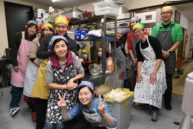I continued my CIP as an assistant English teacher at 末光先生’s cram school this semester. Although not much changed from fall semester, I noticed new things this time. I paid a lot of attention to Japanese communication styles last semester, but this year I couldn’t help but think about the state of English education in Japan.
In the two years I have been studying Japanese, none of my Japanese teachers have ever spoken English extensively during class. However, from what I’ve experienced through the CIP, the teacher says most things to the students in Japanese because they don’t understand much of what she says in English. I don’t know if there’s a reason for this, but I feel like using the target language would be a good way to enhance listening skills and expose the students to new vocabulary even if it’s initially difficult. Also, when the teacher would say something brief in English and ask the students to repeat after her, I imagined that mimicking the pronunciation of a non-native English speaker would probably make it trickier to apply to real-life conversations later on.
I came to the conclusion that maybe a good way to teach English to Japanese students is to have two types of people teaching alongside each other: a native Japanese speaker who has thoroughly studied English and an English native speaker who has thoroughly studied Japanese. That way, both teachers deeply understand the process of learning a new language and can respond appropriately to the feelings of students, the students can aspire to be like their Japanese teacher who has mastered English, and they can absorb and copy the sounds of a native English speaker who is more comfortable with the nuances of the language.
I’m so thankful for 末光先生. Between Halloween celebrations, a birthday party, several dinners, and much more, she has devoted herself to her students and KCJS in many ways. I saw how she used English as a tool to teach her students life lessons and communicate the things she cares about most, showing the next generation firsthand the benefits of learning a new language. She has taught me so much along the way as well. I would be honored to meet with her again someday.


